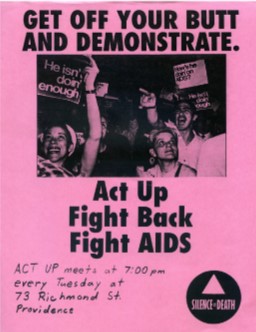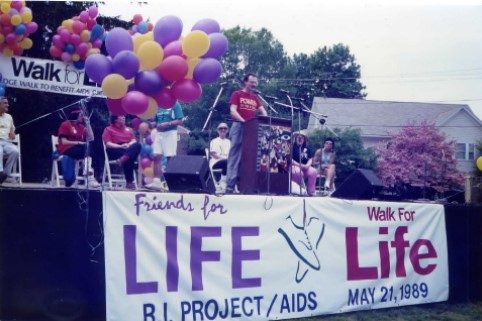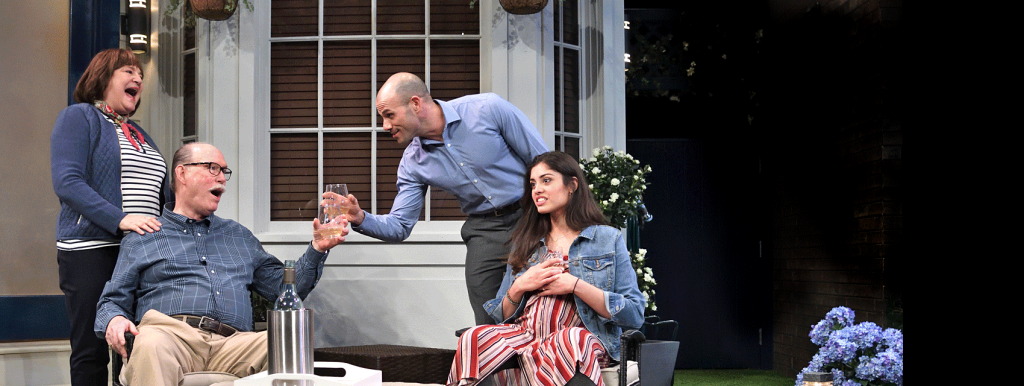Featured photo caption: Select panels from the Memorial AIDS Quilt of Rhode Island on display at Trinity Rep in December 2020. Photo by Michelle Cruz.
A brief history of the AIDS crisis in Rhode Island’s LGBTQ+ community
The legacy of the AIDS epidemic of the1980s and 90s in New York is a key theme of The Inheritance. With some help from the special collections at the Providence Public Library, let’s take a look at the crisis right here in Rhode Island, and what the community did to support its people living with HIV.
The first HIV/AIDS cases in the United States were reported in 1981, with the first known case in Rhode Island confirmed in December 1982. Gay men, especially gay men of color and gay men living in poverty, were (and still are) disproportionately impacted by HIV/AIDS. According to a 1990 report from the Rhode Island Department of Health – the earliest report we could find with racial statistics- 340 per 100,000 men of color in Rhode Island had tested positive for AIDS – a much higher rate compared to white men, of which 55 per 100,000 had AIDS.

But it wasn’t until HIV/AIDS began spreading among heterosexual couples that the government and mainstream culture began reacting to the epidemic. In its June 1983 issue, the Providence LGBTQ+ magazine Options published a scathing critique of the media’s coverage of the epidemic – lack thereof. “Undoubtedly because virtually all of its early victims were gay men, the response of the health establishment and in the general media was slow to develop,” the columnist wrote. “Only in recent weeks has regular reporting on AIDS been seen on the subject, and the national newspaper of record, the New York Times, has yet to publish a story about AIDS on its front page, while such coverage was afforded a story about a herpes outbreak that was killing Austrian Horses.”
Yet even as more about HIV/AIDS became known, gay and bisexual men continued to be scapegoats. Politicians and evangelists across the country argued that HIV/AIDS was “God’s punishment” for being homosexual. Some healthcare professionals across the country refused to treat patients with HIV/AIDS. For thousands of gay men who came of age in the 1980s and 1990s, they had to deal not only with trauma from the deaths of loved ones, but the trauma that came from how they were stigmatized through this new disease.
When society failed them once again, LGBTQ+ people and allies took action to care for the community. As early as 1983, there were reports of Rhode Island organizations such as the Alliance for Lesbian and Gay Civil Rights planning blood drives for people living with HIV. The Rhode Island Project/AIDS, officially incorporated in 1985, trained volunteers to provide people living with HIV and their families with emotional support, and also advocated for fair treatment of people with HIV/AIDS. Through public information campaigns, RIProject/AIDS worked to end the stigma around HIV/AIDS — and to provide facts to the public during a time of confusion and misinformation. This group still exists today as AIDS Project RI.

Beyond directly assisting people living with HIV and their families, Rhode Island activists also made their voices heard throughout the state.ActUp/RI, the Rhode Island chapter of ActUp (The AIDS Coalition to Unleash Power), led many of these protests. When AZT, a drug used to treat HIV/AIDS, first hit the market in 1987, activists held a “die-in” at a Providence CVS to protest the high cost of the drug. The group disrupted then-governor Ed DiPrete’s candidacy announcement in 1988, protesting the lack of attention they felt DiPrete’s administration paid towards the AIDS crisis. And the AIDS Memorial Quilt came to Providence in the summer of 1988, which recorded the names of those who died of HIV/AIDS. Rhode Islanders added the names of those they lost in memory.
This is just a very, very, brief snapshot of what it was like for Rhode Island’s gay community during the height of the epidemic. The Providence PublicLibrary has many more resources regarding the AIDS crisis and Rhode Island’s LGBTQ+ community through the ages. They have also generously shared some of their materials for public viewing in Trinity Rep’s lobby during the run of The Inheritance, so be sure to stop by the next time the curtain closes.
